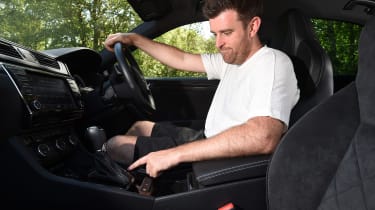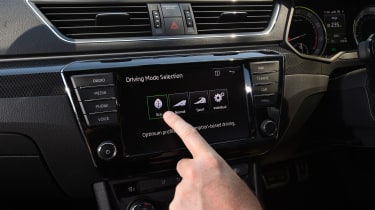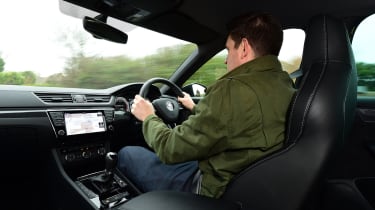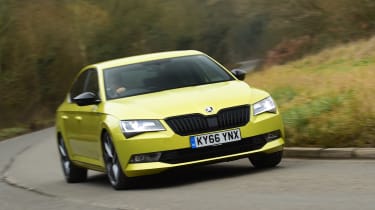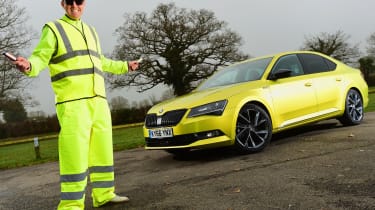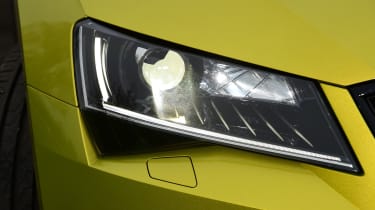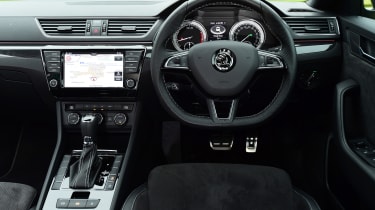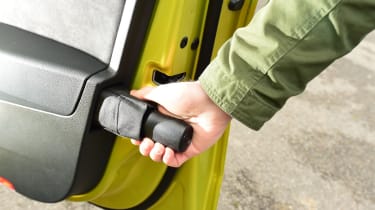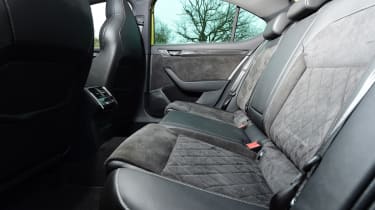Long-term test: Skoda Superb Sportline (2015-2024)
Final report: Skoda Superb Sportline's neat eco tech mixes pace and sleepy efficiency
The competence of the Skoda Superb can make it seem a little boring, but we still love it as much as ever. It was no surprise that the Skoda took the Best Family Car crown at our 2017 New Car Awards and, needless to say, we’ll be very sorry to see it go.
Mileage: 7,084Economy: 41.2mpg
We all like a car with a bit of power, whether it’s for safely overtaking dawdling farm machinery or just for those occasions when you can’t resist the sensation as your car surges at the horizon. The problem is that, as a general rule, more power will mean bigger fuel bills. Those tend to get harder to stomach when you realise that the extra grunt you’re paying for the pleasure of at the pumps is lying dormant most of the time.
The 1.4 TSI ACT petrol engine in our Skoda Superb is one method of achieving the old performance-vs-economy balancing act that many modern cars try to walk, because the Skoda has some advanced equipment under the bonnet to boost power and efficiency. ACT stands for Active Cylinder Technology, and it allows the engine to put half of its four cylinders to sleep at opportune moments.
Used - available now

2019 Skoda
Superb
16,132 milesAutomaticPetrol1.5L
Cash £17,506
2018 Skoda
Superb
38,623 milesAutomaticPetrol1.4L
Cash £13,887
2023 Skoda
Superb
84,000 milesManualDiesel2.0L
Cash £13,720
2021 Skoda
Superb
55,672 milesAutomaticDiesel2.0L
Cash £17,600• Best family cars on sale right now
In theory, it means the 1.4-litre petrol turbo can deliver the best of both worlds, offering low running costs but springing to life with a good slug of performance when you give the throttle a kick.
In practice, when you’re cruising along between around 1,400rpm and 4,000rpm with a light foot on the accelerator, a little message appears on the display screen at the centre of the instrument cluster proclaiming “2-cylinder mode”. Flex your ankle and it disappears, but it all happens seamlessly, with no discernible change in the engine note or jerks or vibrations.
The conditions under which the ACT system kicks in mean that it’s essentially a tool for improving the Superb’s motorway fuel economy – and it works. We’ve been consistently getting mpg in the high 30s over mainly urban driving, and on long motorway runs, this regularly climbs well above the magic 40mpg marker.
For a petrol engine, particularly one powering a big Skoda Superb with a modest 1.4 litres and 148bhp, that’s good going, and enough to make you ask whether you need a diesel.
The ACT engine tech is assisted by the Eco setting in Skoda’s Drive mode selection menu that initiates more economy-focused settings for the engine, seven-speed DSG gearbox, power steering and air-conditioning. It takes the edge off the Superb’s responses, but for long-distance drives it’s the setting we routinely reach for.
Also present in the car’s fuel saving armoury is automatic stop/start, but that hasn’t proven quite as unobtrusive as the rest of the kit. The stop/start on our model has a tendency to engage itself fractionally too early, cutting the engine before we’ve come to a complete halt. The biggest annoyance is that the power steering disengages when the engine cuts out.
It’s probably our main gripe with the Skoda, highlighting just how impressed with it I’ve been. It’s a big family car, and that in itself is refreshing in a market dominated by SUVs these days. But it feels thoroughly well rounded with a sprinkling of technology that works well.
Skoda Superb Sportline: second report
Sportline trim promises more excitement, but is our Skoda Superb's 1.4 engine up to the task?
Mileage: 5,160Economy: 39.0mpg
Big, practical, well built, comfortable, reasonably priced; the Skoda Superb is hard to pick fault with. Unless, perhaps, you’re after a bit more excitement.
The big Skoda’s unyielding competence almost works against it when it comes to standing out from the crowd, which is partly why Skoda introduced the Sportline trim last year. It’s also the main reason why we’ve been running one on our fleet.
So can this Sportline model inject the Superb with a bit of extra sporty pizzazz, reinforcing a major dent in the car’s amour? I think it at least makes a valiant attempt.
Outside, once your eyes have become accustomed to the glare of the Dragon Green paint job on our car, the black gloss trim on the grille, mirrors and rear spoiler add a touch of understated Q-car aggression. I still can’t get enough of the lovely two-tone grey and black 19-inch Vega alloys, either.
Inside, the dark, moody theme continues. There’s some fake carbon fibre trim, which is admittedly a little bit naff, but the highlight has to be the thin-rimmed steering wheel and perforated leather. It’s nicely tactile and, as with much of the Superb’s classy cabin, wouldn’t jar in an Audi or a BMW costing twice the price.
So the Superb Sportline looks the part, but unfortunately, its engine doesn’t match up. Under the bonnet of my car is Skoda’s 148bhp 1.4 TSI petrol turbo unit that forms the entry-point to the Superb Sportline range – although a 123bhp version is available elsewhere. It’s smooth and refined, while the DSG auto shifts swiftly during normal driving. But there’s the sense that a bit more muscle in the engine bay would help this supposedly sporty Superb make a better case for itself.
Thankfully, Skoda can offer exactly that in the shape of its more expensive 2.0 TSI petrol and 2.0 TDI engine options, but our car reveals its more modest capacity when you push it hard or catch the turbo sleeping at low revs.
The gearbox, too, can sometimes be slow to respond to a squeeze of the throttle, and although selecting Sport mode sharpens things up, there’s still that lingering suspicion that a bit more shove would help matters. That’s mainly because the Superb steers, grips and stops so well. The Sportline’s firmer suspension dials out some of the body roll and doesn’t impact on the ride comfort. However, it is on the firmer side, so we’d suggest going for the £750 adaptive dampers. Still, the front wheels hang on with tenacity in tight corners.
Of course, there are advantages to the modest 1.4-litre powerplant – in particular the 39mpg we’ve been averaging during plenty of town driving over the past few weeks, plus a more affordable list price if you want the Sportline’s extras. As standard, my Superb comes in at £28,775 with the seven-speed DSG gearbox, but you can get into a manual for even less at £27,375.
It’s fair to say the car’s looks promise a little bit more than the engine delivers in terms of overall excitement, but style over substance? Not a chance.
In the areas that really matter for a large family car, the Superb has got substance to spare. Rear legroom and boot space are outstanding, build quality is great and although it’s a bit dark, the cabin feels genuinely premium.
Skoda Superb Sportline: first report
Our retina-scorching Skoda Superb Sportline has us reaching for our shades
Mileage: 1,455Economy: 37.5mpg
Visibility is crucial to safety on the roads, especially when winter weather and extra darkness conspire against road users trying to see and be seen.
With that in mind, you might think we’d taken a sensible, safety-first approach by specifying our Skoda Superb in hi-vis Dragon Green paint, but no. The outrageous colour scheme and new Sportline trim level actually point to a subtle change of tack for Skoda, which we’re keen to sample.
This is a Skoda and yet it stands out like a hi-vis vest. Having driven it around for a few weeks, I can confirm that some £80,000 cars don’t attract as much attention – and that, of course, is precisely the point.
Skoda has built its name on practical virtues like interior space, value and build quality, but now wants to add more emotion, appealing to buyers’ hearts and their heads.
Enter Sportline trim on the Superb with its gloss black accessories, 19-inch alloys, Alcantara sports seats and, if you’re really brave, exclusive £820 Dragon Green paint.
It still boasts all the traits that make the Superb appealing – it’s just more striking. Rear legroom and boot space are particular highlights, with four adults able to sit in executive class comfort and the luggage compartment displaying an almost insatiable appetite for suitcases, shopping bags, pushchairs and golf clubs.
Our car is a 1.4 TSI petrol model with Skoda’s seven-speed DSG dual-clutch gearbox. First impressions of the powertrain are positive. The 148bhp 1.4-litre turbo munit shifts the big Superb with vigour and impressive refinement, but you do find yourself missing the extra muscle that would come with the 2.0-litre TDI diesel.
The diesel auto’s 340Nm of torque (compared to 250Nm for the petrol) makes for stronger acceleration from low speeds, where the 1.4 TSI can be a little ponderous.
However, slide the shifter across the gate into the manual setting, where you can use the steering wheel’s paddleshifters to hold a lower gear, and this issue can be overcome.
In general, the car is enjoyable to drive while remaining fluid and relaxed for cruising, even without the optional £750 adaptive dampers. It seems a great compromise so far, with the Sportline trim’s firmer Sport chassis settings and 19-inch wheels adding a bit of extra cornering grip and therefore composure, while staying on the right side of comfortable, even over bad surfaces.
However, it’s always going to be the bold greeny yellow colour scheme that hits you first with our test car, although once your eyes have become accustomed to the bright paint, it’s the slick, coal-cellar interior that really stands out.
The dark cabin, with its black headlining, carbon-effect trim and subtle chrome highlights, has a real air of quality about it, to the point that you could almost be in an Audi. The slim ‘super sport’ steering wheel’s dimpled leather feels great while the controls and instruments have the usual Skoda clarity and simplicity to them.
Our car also has the standard LED ambient lighting package that highlights the dash and door inserts with a strip of lights. There are 10 different colours to choose from, and while it might seem a little frivolous, it really adds to what is a genuinely special-feeling environment for a sub £30,000 car.
*Insurance quote from AA (0800 107 0680) for a 42-year-old in Banbury, Oxon, with three points.


